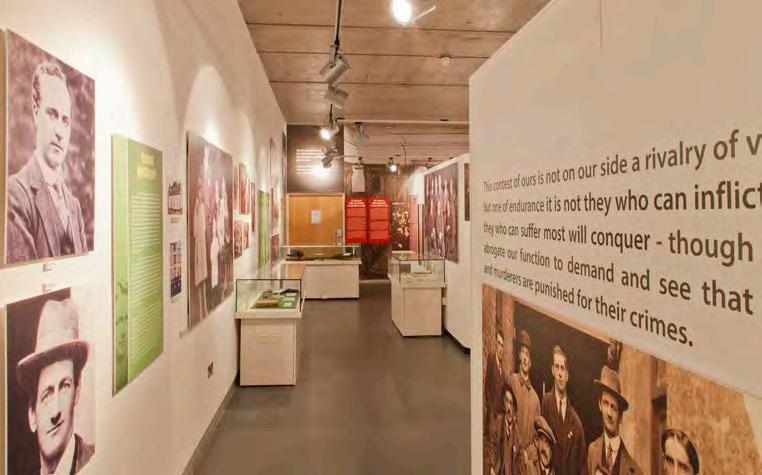
16 minute read
Exhibitions
from Museum Ireland, Vol. 27. Widdis, B. (Ed.). Irish Museums Association, Dublin (2021)
by irishmuseums
MUSEUM IRELAND 2020
Review: Exhibitions
Advertisement
Suffering the Most Cork Public Museum 21 September 2020 – 20 December 2021
Danielle O’Donovan
As you drive into Cork City from the east, along the dual carriageway at Tivoli, two giant banners portray the two lost Lord mayors of Cork, Tomás MacCurtáin and Terence MacSwiney, accompanied by the slogan ‘A City Remembers’. MacCurtáin, Lord Mayor of Cork, was shot in March 1920 as violence in the city escalated. By October, MacSwiney, as his replacement, was dying on hunger strike in a British prison. In December, when crown forces set fire to St Patrick’s Street, hostilities reached a fever pitch.
One hundred years on, in 2020, Cork was to have taken a leading role in the Decade of Centenaries. Exhibitions and events had been planned to fill the cultural spaces of the city, and to spill onto the streets in the form of state commemorations. The appearance on 17 February 2020 of the first case of COVID-19 in Ireland and the announcement of restrictive measures on 12 March overshadowed the centenary of Tomás MacCurtáin’s death on 20th of that month. When full lockdown was announced on March 29, it became clear that Cork City’s year of remembering would be severely curtailed.
Cork Public Museum’s Suffering the Most: The life and times of Tomás MacCurtáin and Terence MacSwiney was launched in September 2020 but has only managed to be open to the public for nine weeks at the time of writing. The exhibition was a collaboration between museum staff and Dandelion Design, with well-known local historian Gerry White, who researched and wrote the information panels. His knowledge of the period is encyclopedic, and he has distilled it into a compelling text.
An excerpt MacSwiney’s first speech as Lord Mayor of Cork forms the gateway to the exhibition:
This contest of ours is not on our side a rivalry of vengeance, but one of endurance - it is not they who can inflict most but who can suffer the most will conquer - though we do not abrogate our function to demand and see that evil doers and murderers are punished for their crimes.
Entering Suffering the Most we are greeted by individual portraits of MacCurtáin and MacSwiney on the left, and the men pictured together on the right.
Credit: Cork Public Museum
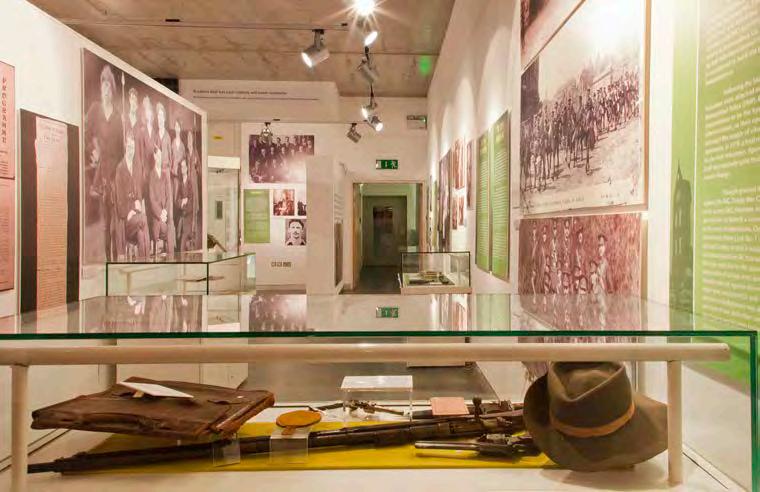
Artefacts give a true sense of the men, and the similar trajectory of their lives.
Credit: Cork Public Museum
Punishment for crimes is certainly a recurrent theme in the exhibition, and so too is suffering and loss. Beyond the gateway text are panels that describe the early lives of MacCurtáin and MacSwiney, a good curatorial decision. It becomes immediately apparent that these two men led parallel lives, had much in common and knew each other well. They were both ‘North Mon’1 boys, both played leading roles in cultural groups, and both joined the Irish Volunteers, ending as first and second in command in Cork City.
Juxtaposed in cases are the texts that they read, their Fáinne pins,2 and their weapons. These objects tell us that MacCurtáin and MacSwiney were thinking, cultured, men of faith, who loved Irish culture and language. While they were not afraid to resort to violence, they also knew that there was power in political action. In 1915, MacCurtáin became the commander of the Cork No. 1 Brigade of the Irish Volunteers, and so was commanding officer during the 1916 Easter Rising, following which both men were interned in Britain. In November 1919 during the War of Independence, under MacCurtáin’s command the Cork Volunteers stepped up their campaign with attacks on RIC3 barracks. Both men were elected to Cork Corporation in January 1920 as Sinn Féin councillors. A well-chosen quote by Daniel Corkery tells us much about their working relationship:
They were exactly opposite in type – Terence MacSwiney being an intellectual for good and harm; his friend being a man of shrewd, homely wit,
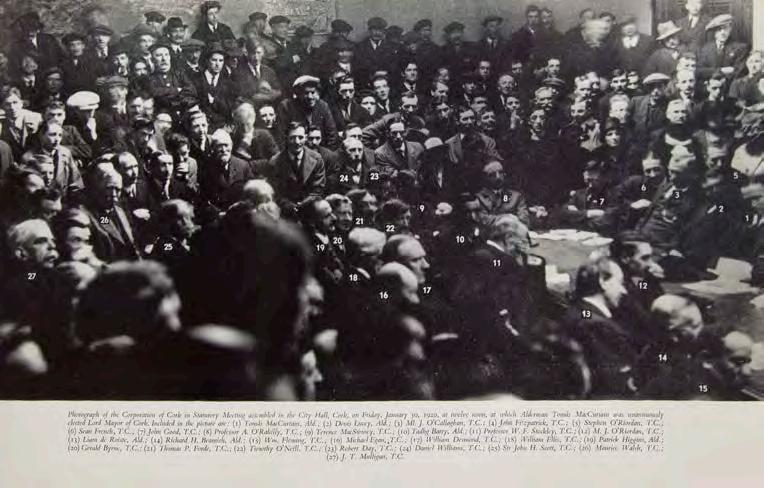
A whole wall of the exhibition is dedicated to the election of MacCurtáin at the Cork City Council meeting on 30 January 1920, and the subsequent election of MacSwiney two months later.
Credit: Cork Public Museum
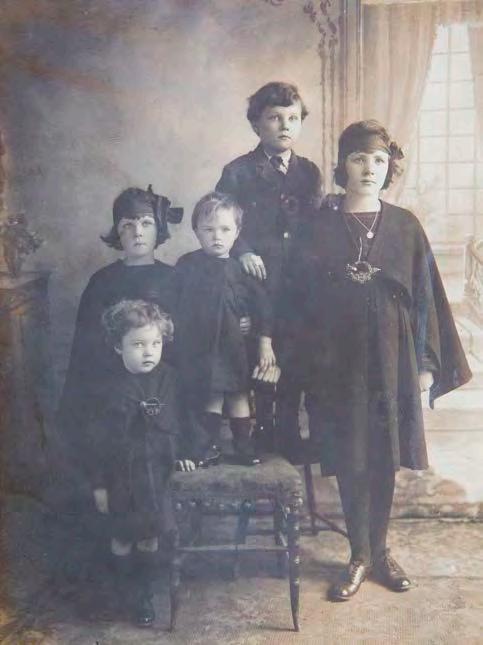
The MacCurtáin children in their mourning costumes. Tomás and Éilís MacCurtáin were members of the Gaelic League, and this passion for Irish culture is clearly reflected in the mourning costumes of their children.
Credit: Cork Public Museum
high-spirited and gifted with an amount of brain, having, moreover, an insight into men and affairs that astonished all who came into contact with him. Exactly opposites, they yet worked most happily in harness.
The end wall of the exhibition is dedicated to the appointment of the two men as Lord Mayor. When elected to lead the new Cork Corporation at a meeting on 30 January 1920, Tomás MacCurtáin’s first act was to recognise Dáil Éireann.4 Within two months he was dead, shot in his home in front of his pregnant wife and children in retaliation for the killing of an RIC officer. The tragedy of his death is captured brilliantly in the images of the MacCurtáin family at the funeral. Indeed, curator Dan Breen’s efforts to collect photographs and lantern slides of Cork, means that the exhibition is richly illustrated throughout. Succeeding MacCurtáin, much of MacSwiney’s time as Lord Mayor was spent on the run. When he was arrested at Cork City Hall in August and charged with sedition, he decided to join a hunger strike that had been commenced by republican prisoners on the previous day. As the exhibition attests, when sentenced he declared that he would be ‘free, alive or dead, within a month’. MacSwiney’s hunger strike in Brixton Prison is set in the context of the hunger strike which continued in Cork throughout the months of August, September and October 1920. The international impact of MacSwiney’s hunger strike is evoked with curatorial precision, including the display of letters of commiseration from around the world after his death on 25 October. His funeral took place in Cork six days later.
Suffering the Most –The life and times of Tomás MacCurtáin and Terence MacSwiney will run through to 20 December, 2021. You can see much of the content online, but for a true sense of these lives lived in parallel, try to see it in person if you can.
Danielle O’Donovan is an architectural historian, museum learning curator and digital engagement specialist and is Programme Manager at Nano Nagle Place, Cork.
Notes
1. The North Monastery is a Christian Brothers secondary
school in Cork.
2. A pin badge worn to show commitment to the speaking
of the Irish language.
3. Royal Irish Constabulary.
4. Meaning ‘Assembly of Ireland’, the Dáil Éireann is the
lower house and primary chamber of the Irish legislature.
Mondrian The National Gallery of Ireland 1 December 2020 – 14 February 2021
Margarita Cappock
Dutch painter Piet Mondrian (1872–1944) was one of the most influential artists of the twentieth century and developed the language of abstract painting. This landmark exhibition at the National Gallery of Ireland is the first major survey of the artist’s work to be held in Ireland. It was organised in collaboration with the Kunstmuseum Den Haag, the Netherlands, which has the largest collection of Mondrian works, some 300 in total. The Dublin exhibition features 40 paintings by Mondrian. The focus of the exhibition is the art that Mondrian made in the Netherlands and Paris before the Second World War and spans five decades of his
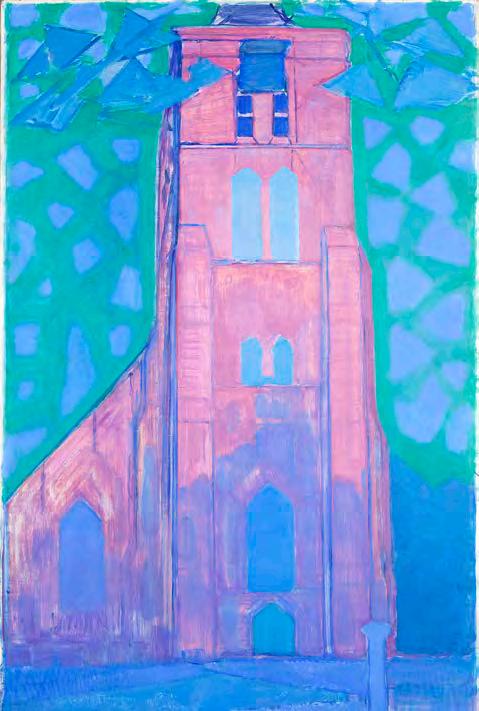
Piet Mondrian (1872-1944), Zeeuws(ch)e kerktoren (Zeeland Church Tower); Church Tower at Domburg, 1911.
Credit: Kunstmuseum Den Haag, The Hague, The Netherlands. Piet Mondrian (1872-1944), Mill at Domburg, 1908.

Credit: Kunstmuseum Den Haag, The Hague, The Netherland
career. Mondrian fled Paris for London in 1938 before eventually leaving for New York in 1940, where he spent the final four years of his life.
The exhibition is divided across the periods of his career under the headings of Zeeland – Light & Colour, Paris – Cubism, De Stijl, and Paris 1930s-40s. It provides a compelling visual narrative of Mondrian’s long artistic evolution, from his landscape paintings to his rigorous geometric abstract works for which he is bestknown.
Born in Amersfoort in the province of Utrecht, Mondrian studied painting at the Amsterdam Academy from 1892-4 and again, part-time, from 1896-7. The earliest work is The Royal Wax Candle Factory (1895) of which Mondrian made many studies when he lived across from it on Ruysdaelkade in Amsterdam. The artist’s deep affinity with nature is in evidence from early on in his oeuvre, and works such as Bleachworks on the Gein, 1900 show the artist painting very much in the Hague School tradition. Indeed, up until Mondrian was almost forty, his art was informed
by his native Dutch countryside, with a preference for repeatedly painting the same subjects: the river Gein, trees and windmills. Several paintings demonstrate the artist’s rootedness in his Dutch heritage.
From early on, Mondrian eschewed the inclusion of the figure and this is evident in his views of the farmhouses and barns that date from his time in Uden, North Brabant, where he spent a year from 1904. These works, with their flattened structures, limited tonalities and emphasis on verticals and horizontals and the blocking in of colour, are a foretaste of things to come. In 1905 the first solo exhibition of Van Gogh’s work at the Stedelijk Museum in Amsterdam had a profound impact. A further interest in theosophy, and the idea that painting could express natural form and a spiritual dimension, led to Mondrian joining the Dutch Theosophical Society in 1909.
From 1908, Mondrian made regular trips to Domburg on the Zeeland coast, then a remote area with a growing artistic community. Here Mondrian’s palette becomes much more saturated with pure, intense colour and there are some stunning examples from his series of paintings of the towers, lighthouses and sand dunes of the region. Dots and dashes of oranges, yellows, blues and pinks abound. The high point of this room is the exquisite painting of the Church Tower, Domburg 1911 with its startling pinks and blues. Arum Lily, 1908 is also particularly striking and it is interesting to note that Mondrian painted flowers right through his career, especially blooms that were tall with a strongly defined structure. In 1909, Mondrian had an exhibition at the Stedelijk, which established his reputation as a leading Dutch avant-garde artist. An exhibition of modern art in 1911, at the same museum, led to the artist encountering Cubism and the work of Picasso and Braque. After this, he made radical changes to his life and art and at the age of 39 he moved to Paris. There he mixed with Dutch and international artists and met Georges Braque, Diego Rivera and Fernand Léger.
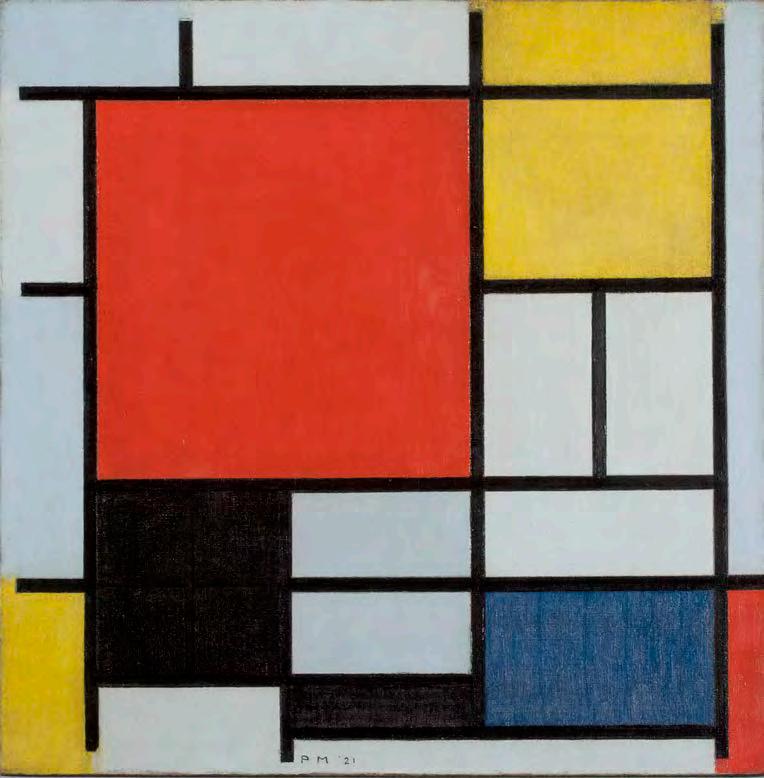
Piet Mondrian (1872-1944), Composition with large red plane, yellow, black, gray and blue, 1921.
Credit: Kunstmuseum Den Haag, The Hague, The Netherlands
The Paris-Cubism room of the exhibition has two main themes: trees and buildings. Here we see Mondrian experimenting with the oval as a compositional device. From 1911-1914 it featured in many of his paintings of trees, buildings, and the sea. Composition in Oval with Colour Planes 2 (1914) is particularly fine and based on demolished buildings he had seen at the time. In June 1914, the Walrecht gallery in The Hague held an exhibition of Mondrian’s Cubist work. He was in the Netherlands to see the exhibition and to visit family when the First World War began, and remained there for its duration.
While in the Netherlands during the war, Mondrian continued to paint. Crucially he also met Theo Van Doesburg with whom, in October 1917, he formed De Stijl magazine, in which Mondrian published the first instalment of his essay ‘NeoPlasticism in Pictorial Art’. Neo-plasticism was the term adopted by Mondrian, for his own type of abstract painting which used only horizontal and vertical lines and primary colours. His growing commitment to abstract art can be seen in the striking Self-portrait of 1918, with the clear reference to the series of compositions of 1917 in which the principles of Neo-Plasticism are expressed. Mondrian withdrew from De Stijl in 1923 following Van Doesburg’s adoption of diagonal elements in his work. Examples of works by De Stijl artists and designers - including Theo van Doesburg, Bart van der Leck, Gerrit Rietveld and Vilmos Huszár – feature in the room devoted to De Stijl.
Mondrian returned to Paris in 1919 and remained there until 1938. Here in the final room, we see the full articulation of his language of Neo-Plasticism where the simple pared back language of verticals and horizontals and his use of primary colours comes to the fore. As a lover of jazz and dancing, he frequented Parisian clubs where he was noted as an idiosyncratic dancer. He began to compare his art to jazz in the 1920s, seeing it as a musical form that was tightly arranged and melodic but allowed space for improvisation and disruption with its syncopated beats and off-kilter melodies. Composition de Lignes et Couleur: III (1937) provides the viewer with an opportunity to witness and enjoy close up Mondrian’s dynamic, sensual and timeless paintings from this time. However, those visitors not especially versed in Mondrian may leave without a sense of the significance of Mondrian’s Parisian studio at rue du Départ, which he occupied from 1921 to 1936 and which was so integral to the application of his ideas in his art, and the inclusion of this would have added further to the exhibition.
Dr Margarita Cappock is an Art Historian, Curator and Lecturer. She is Assistant City Arts Officer at Dublin City Arts Office and Chair of ICOM Ireland.
With thanks to the National Gallery of Ireland for supplying the images for this review.
A British Museum touring exhibition Living with Art: Picasso to Celmins FE McWilliam Gallery and Studio 17 October 2020 – 30 January 2021
Dougal McKenzie
The irony will not be lost on viewers of this exhibition (which within its gallery and museum touring cycle can also be viewed online),1 that in the same way that COVID-19 lockdowns have forced us into watching movies on the internet, so too do we find ourselves (at the time of writing) wandering around art exhibitions in a comparable ‘virtual world’ of viewing.
The exhibition reviewed here comes to us through a generous bequest to the British Museum by film critic and writer Alexander Walker, who, more than most, valued the actual experience of sitting in a cinema. His commitment to buying artworks for his London flat (in his case, exclusively works on paper), suggests that he equally valued and understood the impact art has on us when experienced ‘face-to-face’.
These face-to-face encounters have been few and far between for gallery and cinema goers this past year, but before the December lockdown I was lucky enough to have visited the exhibition twice in its iteration at the F.E. McWilliam Gallery and Studio. I was therefore able to experience the lovely touch provided at the exhibition’s entrance: the very bike that had been used by Walker when he returned to Portadown on visits home. Walker never drove a car; according to his 2004 obituary in London’s Evening Standard , for which he was the film critic for 43 years, he generally eschewed any sort of gadgetry. The display of his bike therefore provided a playful sense of circularity, in joining his art collection for what might be described as the ‘home leg’ of the exhibition’s tour.
On entering the gallery, a ‘Who’s Who’ of 20th century artists’ works on paper unfolded. Walker was drawn towards buying works of art which he found challenging as much as he found them stimulating, and in the process accumulated a quite extraordinary roll-call, extending from a Picasso Cubist still life etching printed in 1911, to a Peter Doig folio of ten etchings produced in 1996.
The extensive exhibition catalogue written by exhibition curator Dr Catherine Daunt displays a forensic eye for detail, equal to Walker’s own meticulous keeping of records of his purchases. It is interesting to note that of the 211 works in his collection, the vast majority of purchases were made from the 1990s onwards, made possible by the successful sales of his film biographies. What was to become an addiction had begun however
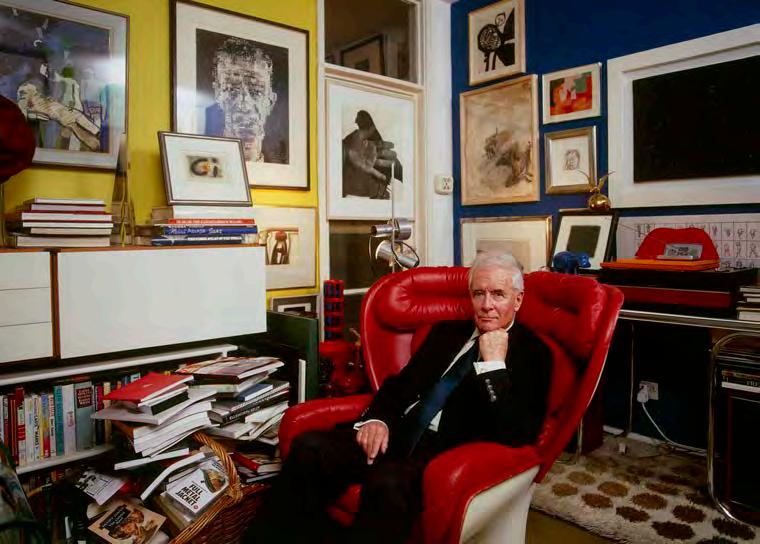
Alexander Walker in his Maida Vale apartment surrounded by his collection, 2002.
Credit: Bob Carter

Alan Davie (1920–2014), Opus 627, 1954, black oil paint on paper.
Credit:The Trustees of the British Museum. Reproduced by permission of the artist’s estate.
in 1964, with the purchase of an unidentified Soviet artist’s watercolour drawing (possibly by Igor Ivanovich Yershov) for £60. By 1968, Walker was able to acquire a more significant work, a Braque lithograph, but it wasn’t until 1990 that his collection really took off, with purchases including a Howard Hodgkin colour etching and a Max Ernst colour lithograph. By this time, Walker’s regular (almost monthly) art-buying habit had extended to thousands of pounds for each work.
The selected works at the F.E. McWilliam Gallery were intelligently and elegantly arranged by curators Catherine Daunt and Riann Coulter, with some really outstanding pieces on show. In many ways there is an increased intimacy and sense of pleasure in looking at an artist’s hand at work when viewing small works on paper, and perhaps because of this, my eye was drawn towards these particular pieces: • A Keith Vaughan gouache, ink wash and crayon with collage on board, from 1964 and titled
Cymbeline II or Fear No More the Heat of the Sun, which in its tender figurative grouping, seemed to reach forward to our present Covid times.
• Equally powerful and resonant, a David Bomberg
World War I charcoal on paper work from 1915, called Study for Billet.
• A joyous Alan Davie black oil paint on paper,
Opus 627 from 1954, in which a figure and an ancient Egyptian pottery design meld into one;
• a Bridget Riley graph paper instruction from 1967, that included her penciled note
‘Luminosity therefore Larger Scale’;
• a Willem de Kooning charcoal on paper, Figure in a Landscape from around 1970-75, displaying the painter’s customary searching, smudging, obliterating lines of a human form;

Philip Guston (1913–1980), Hooded, 1968, charcoal on cream paper
Credit: The Trustees of the British Museum. Reproduced by permission of the artist’s estate.
• and perhaps most extraordinarily (given the recent furores over the postponement of the Philip Guston exhibition in London,
Washington, Houston and Boston), a small 40.5 x 58.6 cm charcoal on paper from 1968 titled Hooded – a bandaged head that displays the nascent formation of what were to become the Ku Klux Klan characters in many of his late paintings.
The closing credits for the Walker touring exhibition are, however, positive. Our longing to return to the cinema to watch the big screen, and also to see artworks in galleries and museums, may lead, thankfully, to a sort of resurgence once lockdown eases again, as we come to realise how much we have missed the social and physical interactions of the cinema, and equally, of going to look at art.
Walker’s collection of works on paper, and his motivations for buying them in the first place, underline our human need for this beautifully.
Dougal McKenzie, who lives in Banbridge, is a painter and a lecturer at Belfast School of Art and is a member of the FE McWilliam Gallery and Studio Programming Committee.
Notes
1. https://www.armaghbanbridgecraigavon.gov.uk/f-e-
mcwilliam-gallery-welcomes-british-museum-touring-
exhibition-living-with-art-picasso-to-celmins/









